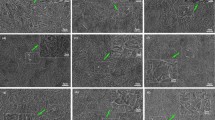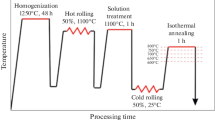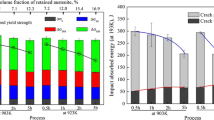Abstract
In the present study, the relationship between initial austenite grain size and mechanical properties of a 5% nickel cryogenic steel was investigated. The microstructures of initial austenite grains and tempered martensites were analyzed by an optical microscope. In addition, a transmission electron microscope was employed to examine the morphologies of reversed austenite and refined tempered martensite laths. Further, tensile and cryogenic impact tests were conducted to evaluate the mechanical properties of the experimental steel. It was found that the impact toughness of the sample steel increased as the size of initial austenite grain decreased and the thicknesses of martensite laths decreased with the decrease in initial austenite grain size. The average grain size of initial austenite in the specimen austenitized at 830 °C for 60 min followed by tempering at 600 °C for 60 min was found to be 19.2 μm, and the maximum value of impact toughness reached 292.5 J. Therefore, the improvement in impact toughness can be attributed to the existence of refined tempered martensite laths and more amount of reversed austenites in the specimen.









Similar content being viewed by others
Change history
29 May 2019
The authors have indicated that they mistakenly provided the wrong TEM micrograph for Fig. 8 of their paper. The authors have provided the correct TEM micrograph, which is shown below.
References
M. Wang, Z.L. Xie, C.G. Li and Z.Y. Liu, The development of Ni-containing cryogenic steels and their industrial manufacturing, in Energy Materials. The Chinese Society for Metals (CSM) and the Minerals. Metals & Materials Society (TMS) (2014), pp. 903–904
S. Ruester, A. Neumann, The prospects for liquefied natural gas development in the US. Energy Policy 36, 3160–3168 (2008)
G.F. Qiao, Y.X. Li, K.M. Zhang, D.J. Li, The present situation and future of liquefied natural gas industry in China. Oil Gas Storage Transp. 24, 1–4 (2005). (In Chinese)
C.W. Marschall, R.F. Hehemann, A.K. Iroiano, The characteristics of 9% nickel low carbon steel. Trans. ASM 55, 135–140 (1962)
C.K. Syn, J.W. Morris, S. Jin, Cryogenic fracture toughness of 9Ni steel enhanced through grain refinement. Metall. Trans. A 7, 1827–1832 (1976)
H.S. Shin, H.M. Lee, M.S. Kim, Impact tensile behavior of 9% nickel steel at low temperature. Int. J. Impact Eng 24, 571–581 (2000)
J.R. Strife, D.E. Passoja, The effect of heat treatment on microstructure and cryogenic fracture properties in 5Ni and 9Ni steel. Metall. Trans. A 11, 1341–1350 (1980)
B. Fultz, J.W. Morris Jr., The mechanical stability of precipitated austenite in 9Ni steel. Metall. Trans. A 16A, 2251–2256 (1985)
X.R. Lei, Q.F. Ding, Y.Y. Chen, X.L. Rui, Effect of niobium on dynamic recrystallization behavior of 5%Ni steel. J. Iron. Steel Res. Int. 20, 38–44 (2013)
X.R. Lei, J.F. Chu, L.Y. He and Q.F. Wang, Effect of niobium on static recrystallization of 5% Ni steel, in Energy Materials. The Chinese Society for Metals (CSM) and the Minerals. Metals & Materials Society (TMS) (2014), pp. 895–901
D.A. Sarno, J.P. Bruner, G.E. Kampschaefer, Fracture toughness of 5% nickel steel weldments. Weld. Res. Sup. 5, 486–494 (1974)
X.Q. Zhao, T. Pan, Q.F. Wang, S. Hang, C.F. Yang, Q.X. Yang, Effect of tempering temperature on microstructure and mechanical properties of steel containing Ni of 9%. J. Iron. Steel Res. Int. 18, 47–51 (2011)
A.K. Lis, J. Lis, High strength hot rolled and aged microalloyed 5%Ni steel. J. Achiev. Mater. Manuf. Eng. 18, 37–42 (2006)
K. Zhang, D. Tang, H.B. Wu, Effect of heating rate before tempering on reversed austenite in Fe-9Ni-C alloy. ISIJ Int. 19, 73–78 (2012)
M. Wang, Z.Y. Liu, C.G. Li, Correlations of Ni contents, formation of reversed austenite and toughness for Ni-containing cryogenic steels. Acta Metall. Sin. Engl. Lett. 30, 238–249 (2017)
K.W. Andrews, Empirical formulas for the calculation of some transformation temperatures. J. Iron Steel Int. 203, 721–727 (1965)
M.X. Zhou, G. Xu, L. Wang, B. He, Effects of austenitization temperature and compressive stress during bainitic transformation on the stability of retained austenite. Trans. Indian Inst. Met. 6, 1447–1453 (2017)
J.Y. Tian, G. Xu, M.X. Zhou, H.J. Hu, Refined bainite microstructure and mechanical properties of a high-strength low-carbon bainitic steel treated by austempering below and above MS. Steel Res. Int. (2018). https://doi.org/10.1002/srin.201700469
J.N. Robinson, C.W. Tuck, The relationship between microstructure and fracture toughness for a low-alloy steel. Eng. Fract. Mech. 2, 377–386 (1972)
Q. Yuan, G. Xu, S. Liu, M. Liu, H.J. Hu, G.Q. Li, Effect of rolling reduction on microstructure and property of ultrafine grained low-carbon steel processed by cryorolling martensite. Metals 8, 518–531 (2018)
Q. Yuan, G. Xu, S. Liu, M. Liu, H.J. Hu, J.Y. Tian, Effects of rolling temperature on the microstructure and mechanical properties in an ultrafine-grained low-carbon steel. Steel Res. Int. (2018). https://doi.org/10.1002/srin.201800318
S. Morito, H. Saito, T. Ogawa, T. Furuhara, Effect of austenite grain size on the morphology and crystallography of lath martensite in low carbon steels. ISIJ Int. 45, 91–94 (2005)
D. Nakanishi, T. Kawabata, S. Aihara, Effect of dispersed retained γ-Fe on brittle crack arrest toughness in 9% Ni steel in cryogenic temperatures. Mater. Sci. Eng., A 723, 238–246 (2018)
Acknowledgements
The authors are grateful to the financial support from the National Natural Science Foundation of China (NSFC) (Nos. 51874216 and 51704217), the Major Projects of Technology Innovation of Hubei Province (2017AAA116), and the Hebei Joint Research Fund for Iron and Steel (E2018318013).
Author information
Authors and Affiliations
Corresponding author
Additional information
Publisher's Note
Springer Nature remains neutral with regard to jurisdictional claims in published maps and institutional affiliations.
Rights and permissions
About this article
Cite this article
Xiong, T., Xu, G., Yuan, Q. et al. Effects of Initial Austenite Grain Size on Microstructure and Mechanical Properties of 5% Nickel Cryogenic Steel. Metallogr. Microstruct. Anal. 8, 241–248 (2019). https://doi.org/10.1007/s13632-019-00523-6
Received:
Revised:
Accepted:
Published:
Issue Date:
DOI: https://doi.org/10.1007/s13632-019-00523-6




